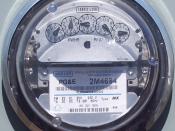It was considered to be an innovation of the future, but for many customers of Pacific Gas & Electric Company (PG&E) in Bakersfield, California, it has become a reality. Their home electric bill is now based on when they use their power, not just on how much power they consume. On July 20th, 2006, the California Public Utilities Commission approved an estimated $1.74 billion plan by PG&E to install the new SmartMeterÃÂ that will benefit the state by improving the speed of power outage restoration, giving customers more options on how to save on their energy bills, and allow electricity usage to be tracked with far more precision than ever before (Pacific Gas & Electric Company [PG&E], 2006). Although PG&E acknowledged different factors that could influence their management planning process for the implementation of the SmartMeterÃÂ, they failed to regard the impact that this new change will have on their residential customers who have a limited household income or who demonstrate an inability to make regular monthly payments; consequently, PG&E will not succeed in helping all of their customers to conserve energy and save money on their electric bills.
The planning for the implementation of the SmartMetersÃÂ by PG&E in California began after a 2002 California Public Utilities Commission order for utility companies to consider programs and tools that offer customers improved options to reduce their electric usage during high-demand situations. When introducing the project, PG&EÃÂs Chief Executive Officer, Tom King, stated, "This technology empowers customers with better information and the ability to make cost-saving choices about the way they use energy. It also gives PG&E new rapid-response capabilities to restore service following an outage, as well as enhanced abilities to assist customers when they phone our call centersÃÂ (Bay City News, Inc. [BCNI], 2006). The meters are actually mini-computers...


